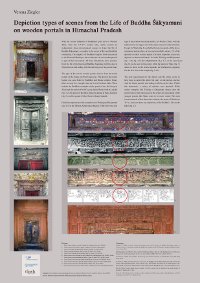| Author | Verena Ziegler |
| Title | Depictions of the Buddha's Life Story on North Indian Wooden Portals |
Abstract
With the second diffusion of Buddhism (phyi dar) and the flourishing of Buddhist culture and Buddhist arts in Western Tibet from, the 10th-14th century C.E., artists created an independent, linear-chronological, manner to depict the life of Buddha Śākyamuni, fitted to the needs of the new Buddhist community. The majority of Buddhist temples from this period in the Western Himalayas, show elaborate carved wooden portals as part of their decoration. All these illustrations show episodes from the life of the historical Buddha, beginning with his stay in Tuṣita heaven and ending with his parinirvāṇa.
The aim of this poster is to present and discuss the decoration of the very few wooden portals that survive in Northern India. These include the portal of the 'du khang in Alchi and,-the portal of the bCu gcig zhal in Wanla, both in Ladakh; the portal of the dKar chung lha khang in Nako, Kinnaur; and the portal of Lha Chuse in Kanji, Ladakh. Comparisons with other examples from Tholing and Khojarnath in the Tibetan Autonomous Region (TAR) show that this type of decoration was characteristic for Western Tibet and that the choice of episodes was a unique development, with the Lalitavistara serving as one of the main sources for the narration.
